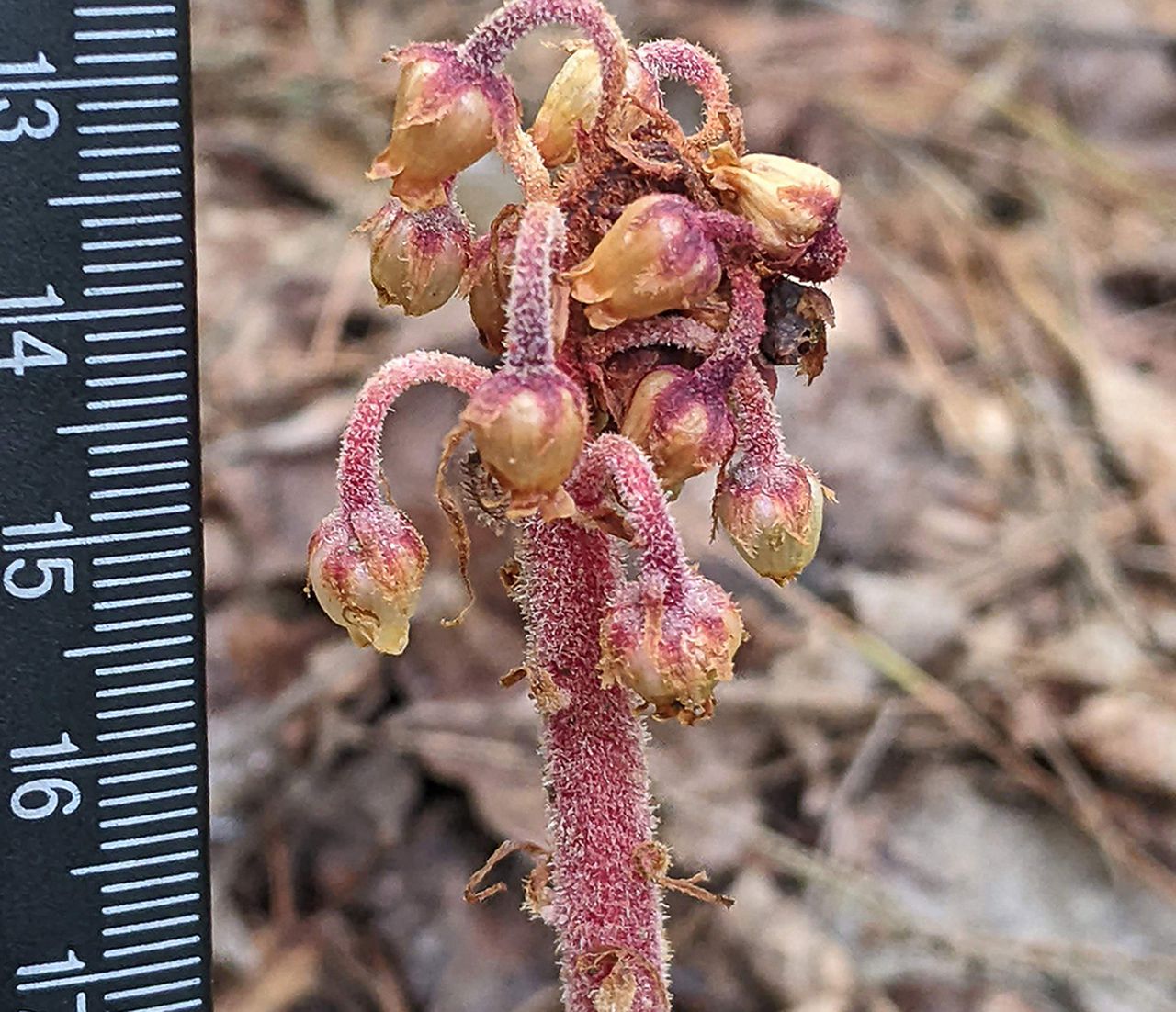Fascinated with rare and unique plants, Skye van der Laan has bushwacked through bogs, waded through swamps and generally trekked off the beaten path in the hopes of getting a glimpse of a plant he has never seen before.
But van der Laan spotted his biggest find — an odd-looking pink parasitic flower — on the side of a trail while taking a stroll with his family last month.
Although people have searched for it for years, it’s the first time that plant, known as pinedrops or by the scientific name Pterospora andromedea, has ever been seen in Massachusetts.
“I was taken by the color. It is such a unique-looking plant,” he said. “It is fuzzy. It is pinkish-red but it has a white fuzz around most of it.”
An amateur biologist who lives near Albany, New York, van der Laan has developed a casual relationship with MassWildlife botanist Robert Wernerehl, so he took a few photos of the plant and emailed them to him with a description of the flower and the area where he found it.
He admitted he had not really done much research on the flower before he sent the email, so he was surprised when Wernerehl got back to him within a few hours.
“They were super excited. They had been looking for this plant for a long time,” he said.
A few days later, Wernerehl and another colleague met up with van der Laan so he could show them where they found the single flower.
MassWildlife is not disclosing the flower’s location to keep it protected from people flocking to it and possibly damaging or removing it. Wernerehl said it is located somewhere in the southern Berkshires, which is the appropriate habitat for the plant.
Pinedrops, fitting to their name, are usually found in pine forests and Massachusetts has plenty of areas suitable for it to grow. Wernerehl said he has been watching and searching for the plant since he was hired as the state’s botanist more than eight years ago.
The plant is commonly found in the Rocky Mountains and Wernerehl said he had seen it when he worked in the upper peninsula in Michigan. It is found on the East Coast but is very rare In Vermont and New Hampshire. It is considered endangered and imperiled in New York. It has never been seen in Connecticut or Rhode Island.

This is a photo of pinedrops, a flower that was discovered in the Berkshires last month. This is the first time it has ever been seen in Massachusetts. (Photo by Robert Wernerehl/MassWildlife)
There is no record of it ever having been spotted in the commonwealth before, Wernerehl said.
The flower is unique enough since it has no chlorophyll and survives on nutrients from fungi threads called mycorrhizal fungi.
“All the carbon they need they get through the mycorrhizal fungi which attaches itself to roots from pine trees,” he said.
The concept is not unheard of: The more common all-white flower named Monotropa uniflora and better known by the common names ghost flower, ghost pipes or Indianpipes, does the same thing. There are also some orchids which draw nutrients from mycorrhizal fungi, Wernerehl said.
Pinedrops is a member of the blueberry family, which includes a large number of different species including cranberries. The pinedrops flower is a similar shape to the flower seen on a blueberry bush, he said.
When the flowers die and dry out, the seeds are scattered by the wind but they do not take root easily.
“When they land the tiny seeds must immediately colonize a special type of fungus in order to germinate, and the chances of that occurring are extremely small,” Wernerehl said in writing.
Once it does take root, it is believed to live underground for six to seven years before it is visible, he said.
Beyond the coolness factor of finding a never-seen flower in Massachusetts, a new species that is considered native rather than invasive is good for the ecosystem, he said.
“Having a species-rich flora is something to be proud of,” Wernerehl said. “It is better to have more tree species and more plant species.”
There are more than 2,200 known plant species statewide, and on average, fewer than one new one is found a year. Wernerehl himself discovered a new one last year — a tiny fern called upswept moonwort.
On occasion historic plants which haven’t been seen in years, such as the crested orange orchid, are rediscovered in the state, he said.
Van der Laan said he has also found a few rare plants as well. One of the recent ones is the frog or long bracted green orchid he found in Vermont, which is uncommon in the state, but nothing like his discovery of the pinedrops.
Van der Laan said he grew up playing in the woods, but admits treks with his parents weren’t always his favorite activity. “I loved being in the woods but not the rigor of climbing up Mount Jefferson,” in New Hampshire, he said.
But that changed. And after decades of working as a carpenter, he decided to pursue his passion and took classes through the Berkshire Botanical Gardens to become certified in horticulture. He is now working as a trail builder and maintainer in the Albany area.
“I always have my mind open. I like to quote (comic strip) Calvin and Hobbes, ‘There is treasure everywhere,’” van der Laan said.
Part of his passion is to check out different ecosystems, and that means getting off the traditional trails to see what he can find. Van der Laan said he enjoys spotting different fauna and flowers to see where they grow and how they survive and thrive.
“There is the thrill of finding something but it is mostly luck,” he said. “I just love plants and seeing new stuff and I don’t mind seeing old stuff either.”






